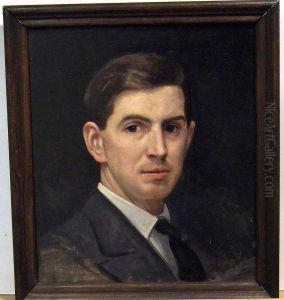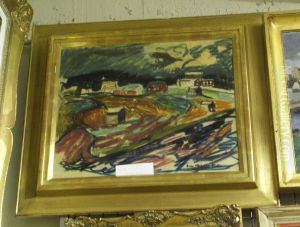Erik Gustav Gothe Paintings
Erik Gustav Gothe was a Swedish sculptor and artist born in the late 18th century. His contributions to the world of art are most notably within the neoclassical movement which was prevalent at the time. Gothe was born on January 25, 1779, in Stockholm, Sweden, into a period that was defined by a strong interest in the classical antiquity, which greatly influenced his work.
Gothe's educational journey in the arts began at the Royal Swedish Academy of Fine Arts, where he honed his skills and became deeply immersed in the neoclassical style, which emphasized simplicity, straight lines, and a return to the ideas and aesthetics of ancient Greece and Rome. This education laid the groundwork for his artistic career, as he absorbed the teachings of the masters before him and learned the techniques that would define his own sculptural works.
After completing his studies, Gothe furthered his education and experience by traveling to Paris, a center for the arts and culture during that era. In Paris, he was exposed to the works of prominent neoclassical artists, which included the likes of Jacques-Louis David and Jean-Antoine Houdon. The influence of these artists and the vibrant artistic community in Paris had a profound impact on Gothe's style and approach to sculpture.
In 1804, Gothe ventured to Rome, which was a rite of passage for many artists of the neoclassical movement. It was in Rome that he truly flourished as an artist, studying ancient Roman sculptures and the works of Italian masters. During his time in Italy, he created one of his most notable works, 'A Sleeping Faun,' which was later purchased by the Swedish king. This work exemplified the neoclassical ideals of harmony, balance, and the beauty of the human form.
Erik Gustav Gothe's career continued to progress as he returned to Sweden, where he became a respected artist in his own right. He worked on various commissions and projects, many of which were influenced by his time in Italy and France. His sculptures often depicted mythological themes and were characterized by their elegance and attention to detail.
Despite his success, Gothe's life was not without its difficulties. He faced the challenge of living in the shadow of the more famous Swedish neoclassical sculptor, Johan Tobias Sergel. Nevertheless, Gothe carved out a niche for himself and built a body of work that was admired by his contemporaries.
Erik Gustav Gothe passed away on November 23, 1832, in Stockholm. His legacy is marked by his dedication to neoclassicism and the enduring beauty of his sculptures. Today, Gothe's works can be found in museums across Sweden, serving as a testament to his skill and his contribution to the artistic heritage of his country.

